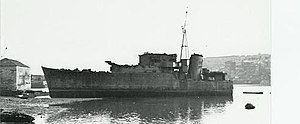
Summary
HMS Porcupine was a P-class destroyer built by Vickers Armstrong on the River Tyne.[1] She was ordered on 20 October 1939, laid down on 26 December 1939 and launched on 10 June 1941. She was commissioned on 31 August 1942, but had a relatively short active career. She was torpedoed in 1942 but salvaged and not finally broken up until 1947.
 "HMS Pork", the front half of HMS Porcupine
| |
| History | |
|---|---|
| Name | HMS Porcupine |
| Ordered | 20 October 1939 |
| Builder | Vickers Armstrong |
| Laid down | 26 December 1939 |
| Launched | 10 June 1941 |
| Commissioned | 31 August 1942 |
| Nickname(s) | HMS Pork and HMS Pine |
| Fate | Torpedoed and crippled by U-602. Cut into two by the Royal Navy. Both halves converted into two individual accommodation hulks known as HMS Pork and HMS Pine. |
| General characteristics | |
| Class and type | P-class destroyer |
Career edit
On 11 November 1942, along with the Dutch destroyer Isaac Sweers, Porcupine helped rescue 241 men from the ship Nieuw Zeeland, a Dutch troop transport that had been torpedoed by the German submarine U-380 at 35°57′N 03°58′W / 35.950°N 3.967°W – about 80 miles (130 km) east of Gibraltar, in the Mediterranean Sea.[2]
Porcupine was under the command of Commander George Scott Stewart RAN when U-602 torpedoed her whilst she was escorting the depot ship Maidstone from Gibraltar to Algiers on 9 December 1942.[3] U-602 fired four torpedoes at Maidstone, one of which hit Porcupine; the other three missed both British ships.[4]
The attack killed seven men but left most of the ship intact – except for critical localised damage that nearly split the ship in two.[2] The destroyer Vanoc rescued all of her crew except a skeleton contingent. After topweight was jettisoned in an attempt to reduce an increasing list, Exe took her in tow. The next day a French tug took over and delivered Porcupine to Arzew, Algeria.[2]
In March 1943 she was towed to Oran, where she was declared a total loss.[2] French dockworkers there cut the damaged ship into two halves before a decision was made to strip them of all guns, ammunition, mountings, stores, etc., and tow them to Britain. The two parts were ballasted and brought to Portsmouth in June.[5]
Once the two pieces were back in Portsmouth, the fore part of the ship was known informally as HMS Pork, and the rear part as HMS Pine.[3] Reconfigured as accommodation hulks, the two halves were commissioned under those names on 14 January 1944 as Landing Craft Base Stokes Bay, in Portsmouth.[3] They were eventually paid off on 1 March 1946, before being recommissioned for the Commander of Minesweepers on 1 April 1946.[3] Porcupine then became a tender to HMS Victory III.[3]
Fate edit
Porcupine was finally paid off on 31 August 1946.[3] On 6 May 1946 she was listed as sold, and in 1947 broken up somewhere on the south coast of England – but reports differ as to whether or not this was at Plymouth, Portsmouth or Southampton.[2][3]
Notes edit
- ^ "NMM, vessel ID 373573" (PDF). Warship Histories, vol iii. National Maritime Museum. Archived from the original (PDF) on 2 August 2011. Retrieved 26 November 2011.
- ^ a b c d e "HMS Porcupine (G93)". uboat.net. Archived from the original on 7 January 2009. Retrieved 26 November 2011.
- ^ a b c d e f g Warlow (2000), p.111.
- ^ Tomblin (2004), p.92.
- ^ Marine news, (1978), Vol. 32-33, p. 18. World Ship Society.
Bibliography edit
- Colledge, J. J.; Warlow, Ben (2006) [1969]. Ships of the Royal Navy: The Complete Record of all Fighting Ships of the Royal Navy (Rev. ed.). London: Chatham Publishing. ISBN 978-1-86176-281-8.
- English, John (2001). Obdurate to Daring: British Fleet Destroyers 1941–45. Windsor, UK: World Ship Society. ISBN 978-0-9560769-0-8.
- Friedman, Norman (2006). British Destroyers & Frigates: The Second World War and After. Annapolis, Maryland: Naval Institute Press. ISBN 1-86176-137-6.
- Lenton, H. T. (1998). British & Empire Warships of the Second World War. Annapolis, Maryland: Naval Institute Press. ISBN 1-55750-048-7.
- Raven, Alan & Roberts, John (1978). War Built Destroyers O to Z Classes. London: Bivouac Books. ISBN 0-85680-010-4.
- Rohwer, Jürgen (2005). Chronology of the War at Sea 1939–1945: The Naval History of World War Two (Third Revised ed.). Annapolis, Maryland: Naval Institute Press. ISBN 1-59114-119-2.
- Tomblin, Barbara (2004). With Utmost Spirit: Allied Naval Operations in the Mediterranean, 1942–1945. University Press of Kentucky. ISBN 978-0-8131-2338-7.
- Warlow, Ben (2000). Shore Establishments of the Royal Navy. Maritime Books. ISBN 978-0-907771-74-6.
- Whitley, M. J. (1988). Destroyers of World War Two: An International Encyclopedia. Annapolis, Maryland: Naval Institute Press. ISBN 0-87021-326-1.
35°55′N 40°00′E / 35.917°N 40.000°E


